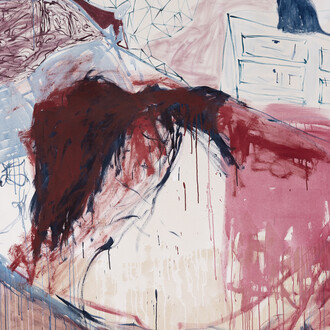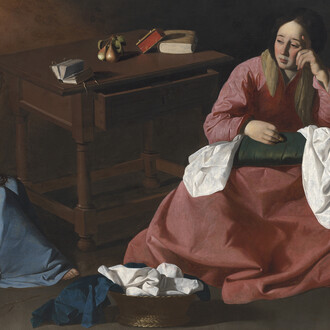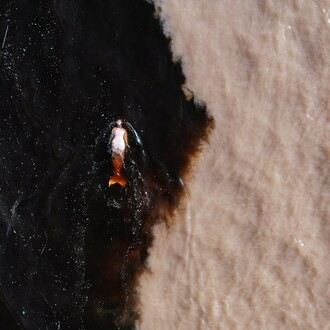Kiefer’s dialogue with Van Gogh becomes part of an ever-expanding chain of artistic and intellectual transmission: a continuum that traces affinities between painting and poetry, landscape and legacy, acts of obliteration and gestures of remembrance.
In this selection of recent works, exhibited at White Cube Mason’s Yard, Anselm Kiefer rekindles an artistic kinship first ignited in his youth, paying homage to the landscapes of Vincent van Gogh. Though more than a century separates the two artists, Kiefer – like Van Gogh – approaches landscape as a resonant site of artistic and philosophical enquiry, where the material presence of paint serves as both medium and agent, summoning a poetics of remembrance, affect and metaphysical reflection.
Kiefer’s engagement with the Dutch master traces back to a formative journey he undertook in 1963 at the age of 18, following in Van Gogh’s footsteps through Europe – from the Netherlands to Belgium, Paris, and finally to Arles, where, in the final years of his life, Van Gogh created many of his most iconic works. These are the very paintings Kiefer illuminates through his own visionary idiom. In the body of work exhibited at Mason’s Yard, notable affinities emerge between the two artists, evident in their shared investment in landscape as a site of existential thought and emotional richness, and in their commitment to a sensorially expressive painterly language. These commonalities, far from eliding difference, render legible their distinct artistic sensibilities.
Taking on a subject closely associated with Van Gogh’s Arles period, Kiefer’s series of sunflower paintings, displayed in the ground floor gallery, offers his own meditation on the motif. Rendered in coagulated impasto, Kiefer forgoes the Dutch painter’s vibrant yellow palette, instead enshrouding his canvases in ashen hues and scorched earth tones, thereby casting the image in a more melancholic register. Inscribed with Kiefer’s distinctive hand, the canvases incorporate passages drawn from poetry and Greek mythology – references that coalesce with the tale of Clytie, the tragic nymph who, transformed by unrequited love for the sun god, Helios, becomes rooted to the earth and turns her face eternally towards the sun. One painting bears a passage from William Blake’s 1794 poem Ah! Sun-flower, in which the poet reflects on the flower’s weariness and its yearning for the ‘sweet golden clime’ that fades daily with the setting sun. Burdened by the weight of monotonous hope, their heads drooping towards the earth, Kiefer’s sunflowers nonetheless persist – assuming an almost anthropomorphic presence as they rise from the ground into the greying or gilded skies above.
Extending Kiefer’s meditation on the motif into another register of image-making, a selection of related photographs – toned silver gelatin prints hung in the gallery’s lift lobby – depict sunflowers, likewise encumbered. Silhouetted and spectral, some rise monumentally from a ground-level vantage, their forms superimposed and subsumed within sedimented layers of photographic process.
Through his invocation of mythic and poetic dimensions, Kiefer endows the natural world with a layered vitality, entwining its perennial rhythms with the complexities and afflictions of human history. In his canvases, nature’s cyclical drama is foregrounded through a language of material abundance – burnt straw, dried vegetation, clay, charcoal, ash – articulating a narrative of decay and regeneration, ruination and rebirth. Within this schema, the landscape becomes a receptacle for all that time impresses upon it: myth, war, language, memory, trauma.
In his series of wheat field paintings, Kiefer embraces Van Gogh’s palette with greater fidelity, rendering terrains of radiant gold that exude the ripeness of harvest. In Van Gogh’s fields – where the golden crop, tilled by reaper-labourers, came to embody nature’s inexorable cycles and the transience of life – Kiefer discerns the symbolic potency of yellow and the paradoxes it encodes. In his own vision, he draws out its dual valence: vitality, joy and hope, but also duplicity, malaise and decay – a dualism that, through his incorporation of gold leaf, accrues a sacred resonance.
In the canvases exhibited in the lower ground floor gallery, these dialectical concerns unfold through form, material and referential expression. In several of the works, the scythe – a recurring motif – features prominently: a symbol of ambivalence that conjures both fecundity and finality, evoking the tension between harvest’s promise and death’s inexorability. Charred fragments of wood call to mind the aftermath of a fire, underscoring the paradoxical fertility such destruction imparts to the land. Articulating Kiefer’s ongoing reckoning with the fraught legacy of his homeland, Sichelschnitt (2019) derives its title from the devastating Blitzkrieg manoeuvre launched by Nazi forces in the summer of 1940 – a ‘sickle cut’ that cleaved through the Netherlands, Belgium and Luxembourg into north-eastern France. In a different register, the monumental Under der linden an der heiden (Under the lime tree – On the heather) (2019) makes titular reference to a medieval German lyric by Walther von der Vogelweide. Suffused with sensuality and reverence for nature, the poem recounts a romantic encounter beneath a linden tree – an Edenic setting where nature shelters and sanctifies human union. Kiefer’s gilded landscapes cast mortal grief and the redemptive possibility of divine transcendence into a shared symbolic field.
Extending the sculptural sensibility of his paintings into the round, Kiefer’s Steigend, steigend, sinke nieder (Rising, rising, falling down) (2016–24) occupies the central space of the lower ground floor gallery. Enclosed within a floor-based vitrine, the work features the long stem of a dried sunflower, suspended upside down from a fissured, desiccated terrain affixed to the vitrine’s ceiling. Below, its scattered seeds lie atop an open book cast in lead. A continuation of his earlier work La berceuse (for Van Gogh) (2010) – which responded to Van Gogh’s 1889 portrait of Madame Roulin – the work draws its title from Goethe’s Faust (1790), the German writer’s two-part tragic masterwork chronicling man’s pursuit of knowledge, transcendence and spiritual fulfilment. To these resonances, Kiefer incorporates the elemental sonority of lead – a recurring medium in his visual lexicon, steeped in associations of historical gravity as well as alchemical promise.
Kiefer’s work traverses a complex inheritance, constituting a space where citation, memory and artistic proposition converge. His dialogue with Van Gogh becomes part of an ever-expanding chain of artistic and intellectual transmission: a continuum that traces affinities between painting and poetry, landscape and legacy, acts of obliteration and gestures of remembrance. Transcending its own materiality, Kiefer’s work reaches towards the metaphysical in pursuit of that which approaches the numinous.
















